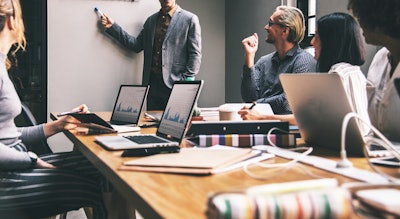
The pace of change is accelerating at a phenomenal rate in today’s marketplace. An enterprise’s ability to succeed in this volatile environment is increasingly determined by how well it keeps pace with its competition and the tides threatening profitable performance.
Not all organizations are equipped to navigate this challenging climate – especially as market dynamics are driven by speed and service levels that fulfill the consumers’ best interests. Customers want their orders now and with free shipping. New products and services are entering the market continuously to fulfill unmatched demand. SKU obsolescence is an ongoing challenge when demand wanes with the same sudden virility of its seasonal emergence. To keep customers engaged, satisfied and delighted, retailers and business-to-business organizations must continuously adapt their processes to maximize their position and tap emerging growth opportunities.
Exponential e-commerce growth in the past decade evidences the benefit that exists for businesses that can strategically adapt to continue bringing new value to customers. An economic segment that amounted to $133.6 billion and 3.3 percent of total U.S. retail sales in 2008 holds significant opportunity for companies able to pivot processes in order to realize a portion of what is forecast by Statista to be a $638 billion online U.S. consumer market by 2020. Achieving greater market share in a U.S. business-to-business online segment projected by Forrester to experience a Compound Annual Growth Rate of 7.4 percent to $1.2 trillion by 2021 will require companies to weather uncertain environments where change is a norm, and do so in a way that meets the best interests of end customers and, importantly, business equity holders.
Just as consumers increasingly adapt their practices to leverage a buying medium that offers anytime, anywhere access for unprecedented convenience and time savings, organizations seeking bottom line growth and greater return on invested capital must coordinate continuous operational process transformation. However, while the end-in-mind is apparent – improved service to end customers that facilitates growth in profit – many organizations have neither the motivation nor the culture that enables them to disrupt the status quo with strategies needed to change ingrained processes. Causes for failure rests in many silos: management behaviors conflicting with change objectives due to obscured benefit realization, employee resistance to “threatening” procedure change, or a lack of funds and resources. Reasons notwithstanding, organizations that fail to recognize the importance of driving cultural shifts through carefully orchestrated tactics will find themselves among the laggards in a changing marketplace.
Regardless of an organization’s directive – to grow, to become more profitable, to become more relevant, to scale, to increase customer service, to establish market position that creates higher equity value for shareholders – an element of change behavior is required to go from a current environment to a future environment that delivers the desired outcomes. An effective change management strategy based on the best practices of mapping requisite changes and implementing incremental movements toward improved operational processes facilitates a sustained competitive advantage, stronger bottom line growth and greater return on invested capital.
Why is a strategy important for change?
In a world where pervasive technologies accelerate change in what people buy, how they buy it and when they expect it to be delivered, businesses incapable of keeping up with the breakneck pace of change face a competitive disadvantage. Organizations that forego or delay a calculated, measured approach to managing process change will struggle to maintain profitability in uncertain business environments rife with complexity.
Conversely, companies targeting both short-term improvements and long-term goals for sustained economic performance benefit from a comprehensive change management strategy that focuses concurrently on both operational processes – and the human resources responsible for driving and maintaining transformation in practices and behavior. An enterprise with a mindset acclimated for change is better prepared to adjust when market forces impact consumer demand, raw material availability or constrained transportation capacity. The organizations capable of executing a change strategy position themselves to perform at the desired level.
Yet, many organizations struggle to drive the necessary transformation required for profitable survival. Germany-based change management and business performance consultant Torben Rick argues that 70 percent of change initiatives fail to meet their target impact for a variety of reasons. Many of those impediments relate to internal dynamics and a failure to effectively craft a strategy that identifies priorities for process transformation:
- 33 percent of change efforts fail because management behavior does not support change.
- 39 percent of change efforts fail because employees are resistant to change.
- 14 percent of change efforts fail due to a lack of adequate funds or resources.
- 14 percent of change efforts fail for other reasons.
Critical to a change management initiative is a precisely sequenced strategy that identifies action phases reflecting broader understanding of the overall organizational impact of the change. Mapping the process, recognizing potential outcomes and preparing for additional result-driven pivots are all actions that play significant roles in effectively transitioning practices to improve and maintain performance gains. Responding to a marketplace shift without a comprehensive strategy for process change threatens potential improvements with functional gaps that could create unforeseen repercussions.
For example, an organization deploying a Transportation Management System (TMS) to improve its logistics management capabilities must recognize the operational changes that need to occur in parallel with implementation of the new technology. Additional human resources are required to maintain the TMS through the input of rates and updates of other pertinent information. With the addition of each new rate or carrier into the system, a time-consuming update is required. Additional testing of the environment also is needed to insure processes are managed correctly, shipments are booked effectively and transportation carriers are paid accurately and quickly. Adding technology into the logistics management equation is only one small part of a process change. Other operational aspects must also be considered, including a re-engineering of processes for maintaining, supporting and managing the technology and human resources required to effectively operate the new service capability.
Without a proper strategy for change management, implementation of new technology applications intended to improve customer service can result in unexpected expenses and potential performance delays that jeopardize the positive impact projected for the change, as well as the overall path to transformation. Operating without a clearly defined change strategy obscures an organization’s ability to, in this case, implement new technology that can be foundational to performance improvement.
Why is implementing a change management strategy so hard?
At their core, business relationships and decisions are driven by a human emotional element. A majority of executives (62 percent) say it is often necessary to rely on gut feelings and “soft factors” when making important decisions, according to Fortune Knowledge Group’s study “Only Human: The Emotional Logic of Business Decisions.” Further, of 720 senior executives surveyed by Fortune Knowledge Group, 61 percent agree that when making decisions, human insights must precede hard analytics. These findings reveal that the drive to initiate change is propelled not just by data and facts, but by the expectation that it will deliver new enterprise value or respond to an emotional response elicited by uncomfortable marketplace conditions.
With a human emotional element still playing significant roles in operational practices, the challenge of change is intensified by a human tendency to avoid an unfamiliar environment. Transformation is hard because you aren’t just altering the rules or the operating procedures. In order to be effective, an entire organization must change. Whether that is accomplished at the top – where executives address shifts in the strategic course – or within the operational environment, where change is most impactful in myriad ways, it requires a disciplined mindset and an acceptance that the change is going to deliver a greater benefit than the current environment.
Compounding the challenges of change management is that the benefits of process alteration are often delay. To realize the success of change, an enterprise must first go through the effort of the change itself, and that takes time. During that time, whether the change addresses strategic or operational directives, the benefits of change are often not recognized fast enough. In response, a reluctance to maintain course emerges among change agents, and support recedes among change champions.
Creating an achievable timeline for change is critical to helping an organization understand the net goal, particularly during the course of resistance and chaos that follows the initiation of a new operational course. Once individuals directly impacted by a transformational shift better understand the end benefits, the disruption to change diminishes and the benefit of the change environment starts to accelerate.
Even for organizations capable of fully implementing initial process change, maintaining an expectation that change is never-ending is difficult. Although a continuous effort may not be required, a continuous mentality of innovation, creativity, sustainability and scalability is integral to effective response in a volatile environment. When a change project yields a new status quo with improved productivity and performance, there’s a tendency toward complacency in the wake of completing what may have once seemed like an insurmountable goal.
In order to maintain competitiveness in a dynamic marketplace, identifying the best business path for achieving strategic goals often requires a shift in organizational culture toward one that is continuously focused on making incremental movements. A business environment is constantly shifting to become more effective, and an operating environment that exhibits determination to stay the course and manages change through the inevitable resistance and chaos underpins an organization capable of sustaining competitiveness in any marketplace conditions.
What is the best approach to initiating change?
For an organization approaching a course change in strategic direction or operational tactics, assessment of the change drivers is important. Why is the change occurring? If there is a reason for the change, is there a validating process that confirms a change needs to occur? Validating the motivation behind a process change confirms alignment with organizational objectives and confirms that implementing the proposed change is mission critical for the business to execute its overriding strategy and achieve the desired outcomes.
Understanding the change itself and whether an enterprise can sufficiently alter processes to achieve objectives helps determine whether the scope of change is appropriate and if a modification of other strategies would reduce the overall impact. Likewise, understanding the full change necessary to drive desired outcomes may reveal the benefit of a phased approach. Often organizations approach change aggressively and, in taking on too much too fast, jeopardize the initiative and anticipated outcomes. A phased approach serves to ease an enterprise through transformation so that it can benefit from the change – often as it occurs – instead of investing effort and resources in a failed attempt.
Close consideration of a change management plan allows broad top-down examination of the enterprise, its business strategy and whether that strategy is aligned with financial objectives. Is the organization itself aligned with those objectives or is change required? Looking within the organization, it is important to determine if the human resources are in the right positions to help lead process change. Is the process for change in the correct sequence? What changes first? What changes second? What changes in parallel? Depending on the goals, implementing change may require an enterprise-wide approach, complemented by segmenting the transformation in a phased manner.
While often change can be abrupt – accepting that it needs to happen, investing in it, experiencing the pain and realizing the benefits – a more moderate phased approach leveraging incremental improvements over time can render desired results while fostering an organizational culture needed to pivot more regularly to address market shifts.
Why is a trusted partner equipped to manage change?
In a business environment where disruption is commonplace and complexity challenges top-line growth and bottom-line performance, many companies are looking at change for the first time. Some of those organizations look at implementing change from the inside out.
Even best-in-class companies experience aversion to change, but their organizations are resilient enough culturally to withstand the resistance and chaos that follows a challenge to the status quo. In many cases, that resiliency is buoyed by partnerships that bring innovative technology, outside-the-box strategic thinking and volumes of real-world experience to bear.
An Enterprise Logistics Provider offers organizations a 360-degree view and requisite relevant experience highlighted by proven change management programs engineered for organizations of many sizes – from small-cap to large-cap – across many industry segments. This lens, colored by expertise gained working alongside thousands of companies, enables service providers to better understand objective viewpoints on process change in order to more effectively organize and sequence transformation to be successful. A trusted advisor closely partnered with an enterprise client offers an experience-biased perspective to strategize and execute a change management plan, then continuously monitors and measures performance to ensure the plan aligns with the enterprise’s long-term goals.



















